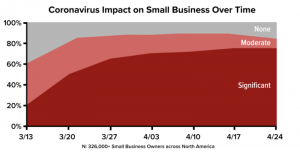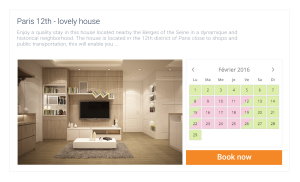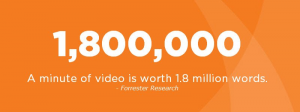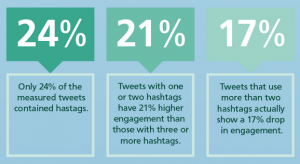— September 24, 2018
Creative content is the most important part of a successful mobile video ad. Your photos, videos, Stories, copy, and music matter. They are the only things your customers see and therefore are your biggest chance to grow your business.
That’s why we’re opening our guide to mobile video with this article. We want to inspire you to dive into Facebook and Instagram ads with the mind of a creator. Let’s look at the different ways good creative helps marketers win, along with examples of successful ads to prove it.
Good creative = Great ROI
To put it bluntly, the creative quality of your video ads directly affects your campaign results. When you’re competing for attention against similar brands, whether large or small, good creative plays a huge part in ad success.
Facebook and Instagram are now video-first platforms. We’re not just saying that. Here are some of the numbers that should already have convinced you to use video in your campaigns:

From Facebook’s point of view, your creative simply affects ad delivery. Bad creative equals bad relevance scores. And bad relevance scores mean more expensive CPM.
Bad creative = bad relevance scores
On the other hand, good creative equals good ad delivery.
Facebook’s relevance score is judged on a combination of ad creative + audience targeting. They give the example of a handbag ad for three different audiences, ranging from broad to specific.
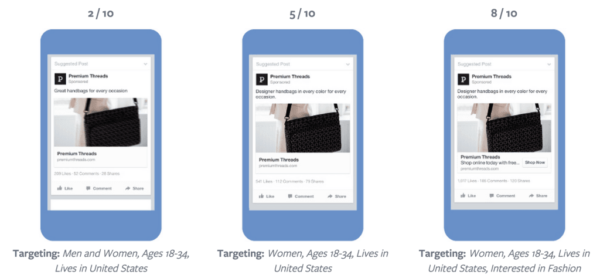
Your ad creative has to fit your audience in order to deliver solid ROI: It’s not enough to create a single ad that recycles old content from who knows where. In fact, Facebook audience research is a great place to start brainstorming ideas. You can use demographic and interest data to build personas and then create highly specific ads just for those personas.
The value of custom creative is in the way you make your audience feel. When they see an ad that looks like it was made just for them, you’ll see bigger payoffs.
Good creative grabs attention in the news feed
The news feed is a really congested space where you have to fight tooth and nail for audience attention. Having creative content is the best way to stand out in the news feed.
On average, we scroll through about 300 feet, or about 91 meters, of feed every day. That is the same size as the Statue of Liberty in New York. Not only that, but according to research by Microsoft, the average worker is distracted or interrupted every 40 seconds while on their computer. In the age of smartphones, there’s always something shiny and new to look at. The combination of endless scrolling and ceaseless distractions makes the news feed a challenging environment for marketers.
Most mobile-phone use can be described as “on the go.” People view video in an unplanned fashion, in small bites throughout the day. The motivation to check in frequently is motivated by discovery and connections with friends, family, groups, and businesses.
As marketers, we have to be laser-focused on building video experiences that are quick, sticky, engaging, and fun. We also have to build content that’s native to mobile video to capture people’s tap-and-scroll behavior.
Stouffer‘s used a high-energy video of people and vegetables to attract health-conscious customers to its Fit Kitchen Bowls.
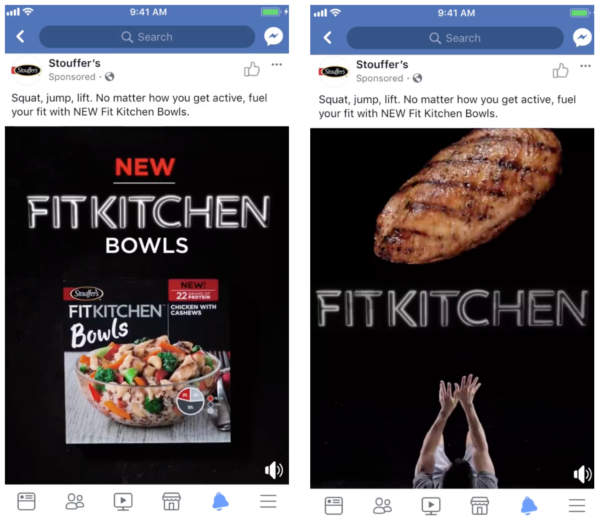
The use of motion and color against a dark background made these videos stand out. In their two-month campaign, Stouffer’s saw increases across the board in brand awareness, purchase intent, and reach.
When it comes to creating eye-catching creative, the secret is in the video design. The most successful ads follow basic design principles to draw viewers toward a particular action. If you’re not sure where to start, check out our library of video ad templates designed with the news feed in mind.
Good creative helps you get ahead of trends such as Stories
Macro trends in media take a long time to catch on. If you can learn to master new video formats, you can win over a loyal audience before your competitors even know what’s happening.
Two major shifts happened that led to the mobile-first video trend:
- Desktop-to-mobile: took place after the iPhone and other smartphones were introduced (2007)
- Television-to-mobile: took place after the Facebook newsfeed was introduced (2006)
The rise of video on Facebook and Instagram feeds was the lynchpin for the shift to mobile video. Ever since 2006, viewers have been spending their free time on their phones, scrolling through social media, instead of watching TV. Yet advertisers are still adapting to the world of mobile video.
Now, we are seeing the beginning of the shift from news-feed content to Stories. This change started with Snapchat and exploded with Instagram Stories. Instagram Stories is now one of the fastest-growing platforms ever. You don’t want to be left behind.
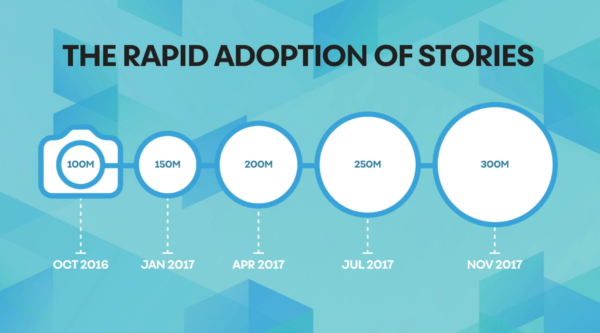
Instagram Stories has grown rapidly since launching in 2016 and now has over 300 million monthly active users. On top of that, 450 million people use WhatsApp status daily, and more than 150 million use Facebook Stories daily. The Stories format is here to stay, and it’s set to dominate your content consumption going forward.
With every trend, consumers move first, and businesses are slow to adapt. They’re reluctant to change the way they communicate and do business. That leaves a huge opportunity for adaptable marketers and advertisers who are quick to follow the money by jumping on emerging platforms, such as Stories.
MailChimp took the plunge with Stories ads in a campaign to expand their audience of professional marketers. They used a combination of news-feed and Stories ads to show how MailChimp’s automation tools were like a “second brain.”
MailChimp’s Stories ads were focused on the call to action to get prospective customers onto their site as quickly as possible. Their targeted, comprehensive approach reached the right prospects, who were more likely to consider MailChimp after seeing the ads.
We’re just starting to discover what good Stories creative looks like, but the most important thing is to create content that is native to the format. That means vertical videos and the use of Stories interactions, such as swiping, tagging, and polling.

Good creative gets the message across quickly
Not too long ago, TV was the main vehicle for ads. Then smartphones came along and revolutionized the way we consume content. Now we have to shift from linear narratives to much shorter ad formats.
TV ads typically consisted of
- 30-60 seconds of narrative, and
- a final frame showing the product and a call to “buy now!”
You can see the template in action in this Guess Who? ad from the ’90s.
You see the kids play the game before you’re asked to buy it (and are warned that the cards don’t actually talk). This format worked as long as viewers watched the entire ad.
TV ads followed a typical story arc, as illustrated here:
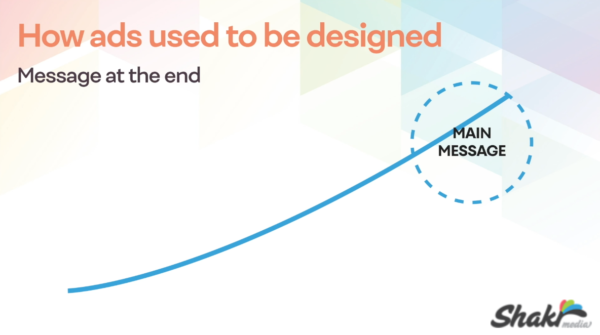
But if you stopped watching after 20 seconds, you would miss the message.
With mobile video marketing, we can’t wait till the end to get to the point. We need to move the main message to the first few seconds because people don’t have the patience to keep watching as long as they used to.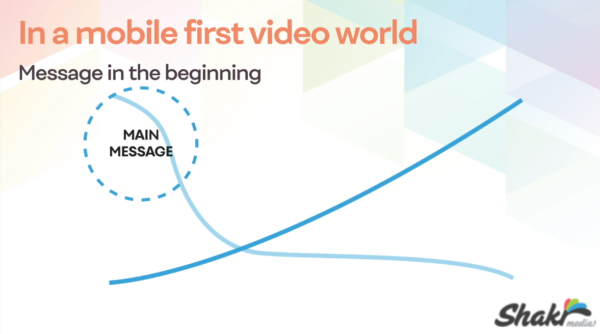
In fact, many mobile video ads don’t have a “story” at all; instead, they use a series of images and text to help build brand and product recognition.
Perrier‘s ads for Instagram and Facebook grab your attention with bright colors and mesmerizing illustrations, all the while drawing your eye to the Perrier bottle.
Their 1.5-month campaign resulted in a 17-point lift in ad recall and a 4-point lift in purchase intent due to their mobile efforts.
When you don’t have a lot of time to make someone remember your brand, simple, eye-catching design can cause someone to linger over your ads and feel positive about your product.
(Ad) Content Is King
When it comes to making successful video ads for Facebook and Instagram, nothing beats well-designed and well-executed content. The best videos will speak to the right audience, stand out in the feed with exceptional design, take advantage of trends, and get to the point quickly. Keeping these basic points in mind, you’re ready to learn more about the technical aspects of designing and launching your ads.
Digital & Social Articles on Business 2 Community
(64)
Report Post


